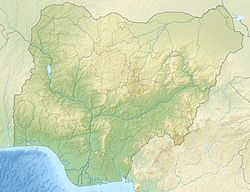| Ameki Formation | |
|---|---|
| Stratigraphic range: Lutetian-Bartonian | |
| Type | Geological formation |
| Unit of | Bende-Ameki Group |
| Lithology | |
| Primary | Shale |
| Other | Sandstone, siltstone |
| Location | |
| Coordinates | 6°00′N7°00′E / 6.0°N 7.0°E |
| Approximate paleocoordinates | 1°36′N1°30′E / 1.6°N 1.5°E |
| Country | Nigeria |
| Extent | Niger Delta Basin |
| Type section | |
| Named for | Ameki |
The Ameki Formation is a Lutetian to Bartonian geological formation located in Nigeria. It belongs to the Bende-Ameki Group, which also consists of two formations namely Nanka Formation, Nsugbe Formation. [1] [2]
